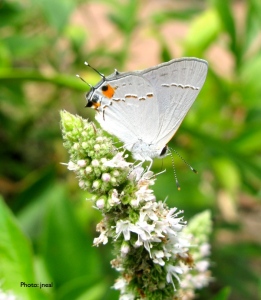The sand wasp, Stictiella formosa is a butterfly wolf. These wasps dig nests in sandy soil and hunt prey to feed their offspring. They prey on a variety of small Lepidoptera, often striking butterflies or skippers while the butterflies drink nectar at flowers. Among prey that have been observed are the Gray Hairstreak, Snout Butterfly and numerous skippers*.
A single butterfly does not provide sufficient nutrition for this sand wasp to fully develop. Stictiella formosa lays its egg on the first prey captured, then adds additional butterflies. Nests may contain as many as 10 butterflies. The butterflies are stacked in the cells end to end, with the wings up and out of the way. The developing wasp larva can start at one in of the cell and eat its way through the multiple prey in a linear fashion.
*James E. Gillaspy, Howard E. Evans, Cheng Shan Lin. 1962. Observations on the Behavior of Digger Wasps of the Genus Stictiella (Hynienoptera: Sphecidae) with a Partition of the Genus. Annals of the Entomological Society of America Sep, 55: 559-566.
DOI: 10.1093/aesa/55.5.559


Pingback: Living With The Butterfly Wolf | Living With Insects Blog